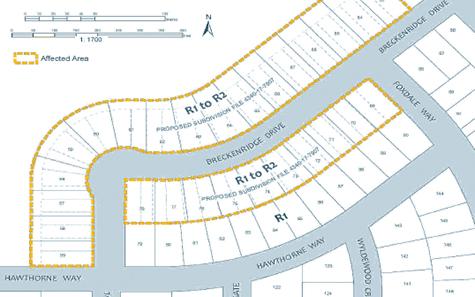A large contingent of homeowners in Niverville are celebrating a victory. On September 19, Niverville’s town council held a public hearing to address a rezoning request by developers Fifth Avenue Estates (FAE). The proposal outlined a request to change the zoning of a series of undeveloped lots bordering Breckenridge Drive from R1 Single Family Residential to R2 Two Family Residential.
Around 60 residents attended the meeting, 51 of whom signed in for an opportunity to make their appeal to council. As the developers behind the proposal, Cornell Friesen and Clint Hiebert were also in attendance.
After hearing addresses from Hiebert and 23 affected residents, council held a unanimous vote to defeat the motion.
At the onset of the public hearing, Mayor Myron Dyck indicated that council had three options: one, to table the hearing to another date should council need more time to make a decision; two, if no council member voted for a second reading on the proposal, the motion would be automatically defeated; and three, if council decided to approve the request, objectors would be notified of their rights to take their appeal directly to the Manitoba Municipal Board.
The change to an R2 zoning would have granted the developers the option to build duplexes in an area currently designated for single family dwellings. The duplexes being tendered were to have separate titles and would not have included condominiums or rental units.
Hiebert opened the council hearing by making clear his intention to address only council and not to enter into a debate with objectors. He cited FAE’s disappointment with the public’s reaction to their proposal.
“To my understanding, this is largely the result of a few individuals who have been spreading misinformation and rumour, and essentially fostering what amounts to hysteria and a mob mentality about what is pure conjecture on their parts,” Hiebert told council.
He offered assurances that the duplexes would be subject to high standards of construction and specific design controls, and the price point would make the homes unattractive for rental purposes. The duplexes were to be set back far enough to allow enough parking for two vehicles per unit.
“In many cases, due to Fifth Avenue’s stringent design controls, these duplexes will be worth the same and more, per side, than a large majority of the houses in the surrounding areas,” said Hiebert. “Fifth Avenue Estates’ goal for this subdivision was and remains to build a community where someone just starting out could [find] affordable housing. Then over time, [they would have the] opportunity to upgrade as their family grows, all within the same development. This is what builds a town and allows citizens to take ownership and pride in their community.”
At the closing of Hiebert’s address, he and Friesen withdrew from the public meeting, indicating that Hiebert’s ongoing recovery from an automobile accident prevented him from staying further.
Council opened the floor to residents in attendance, many of them audibly perturbed by FAE’s accusations and quick departure. Residents took to the open mic, one by one, passionately beseeching council to consider the current residents before drawing in newcomers.
“When we all purchased properties here, there was a zoning map for what the development would [look like] for the future,” says a property owner on Breckenridge Drive. “This was R1. We also had to sign ‘Design Control Guidelines’ to enhance the neighbourhood and therefore promote a growing and profitable venture. This was a stand to protect [the buyer’s] investments and further prevent from being undermined by a developer who forgot all the heart that goes into building communities.”
This homeowner echoed many objectors’ sentiments when he suggested that the proposed change to the development was not what homebuyers had bought into, and that the developers should be held to the same strict standards they themselves require of the area’s current residents. He handed council a petition, signed by 180 homeowners all opposed to the zoning change.
Other residents were concerned with what such a change would do to their current property value and, subsequently, resale value down the road, citing consistency in home styles as the best way to ensure this. While FAE feels that duplexes will not affect single-family home valuations because appraisers look at similar size properties for comparisons, at least two homeowners disagreed. One suggested that she’d been through a similar experience in another community and lost significant value when she sold. Another, himself a real estate appraiser, says that conformity in the neighbourhood helps determine value.
Still others were concerned about the precedent this might set when other developers change their minds about zoning when market demands fluctuate.
“Council, acting as a non-biased body in keeping with a public hearing, listened to both the presenter, those in favour of what the presenter brought forward, and then those that spoke in opposition,” says Mayor Dyck. “After carefully weighing both sides, they made their decision based on what they believed to be the best use of land on the lots as listed.”
The gathered crowd broke into applause at council’s decision.
“Of course, we had people saying this is a done deal and we don’t stand a chance, as who are we to fight tooth and nail against a developer?” says the Breckenridge homeowner. “[We wondered], ‘Are we just going through the actions to be told this is already a signed deal?’ The answer back was positive from council… thank you, council, for standing up for your people. It’s not always about money, it’s pride and communities banding together to show that we do have a voice in today’s society.”


